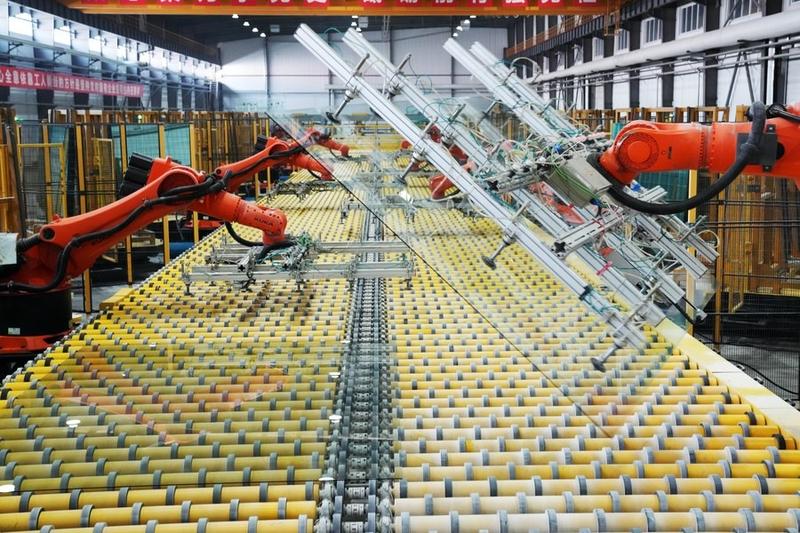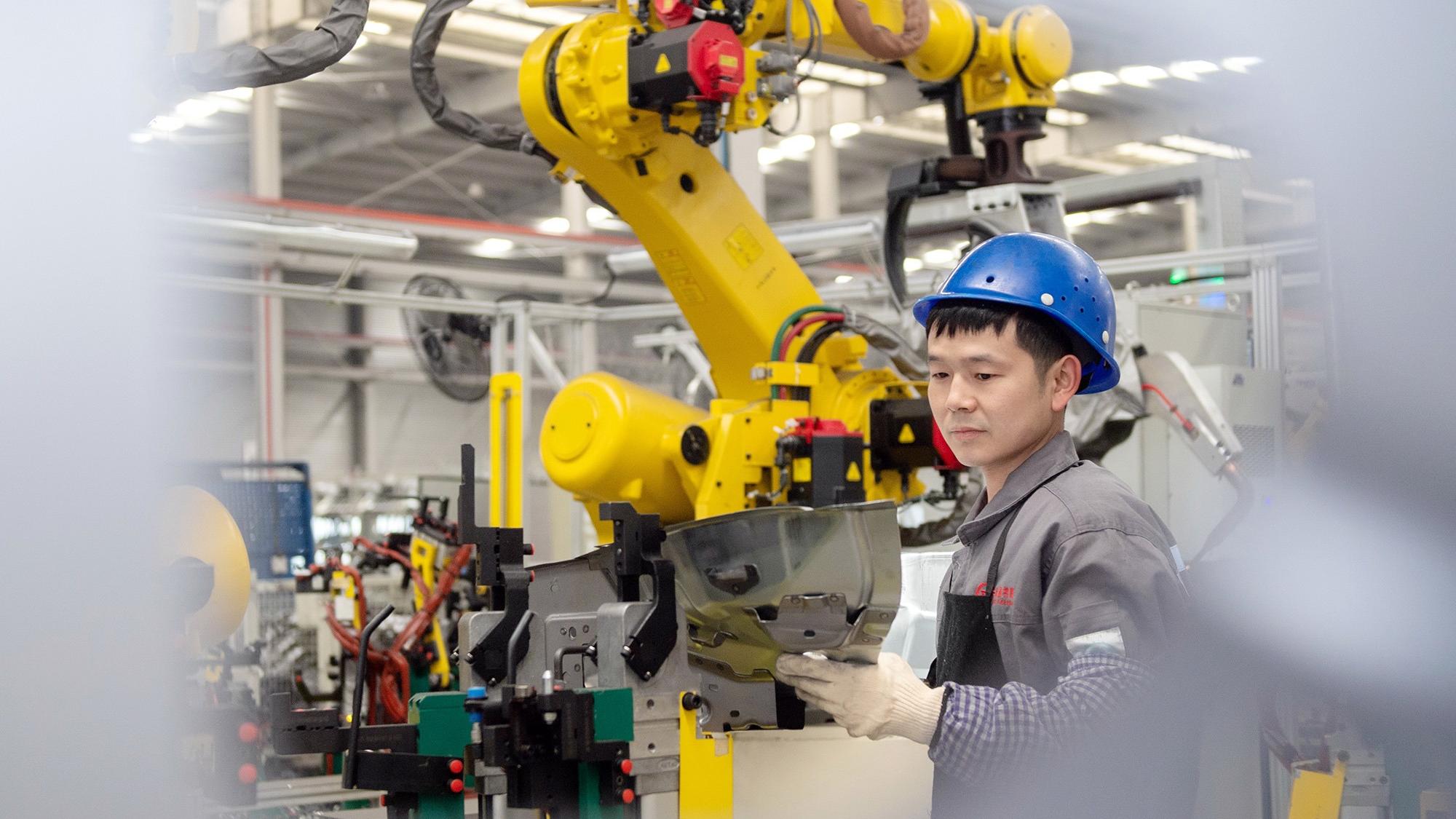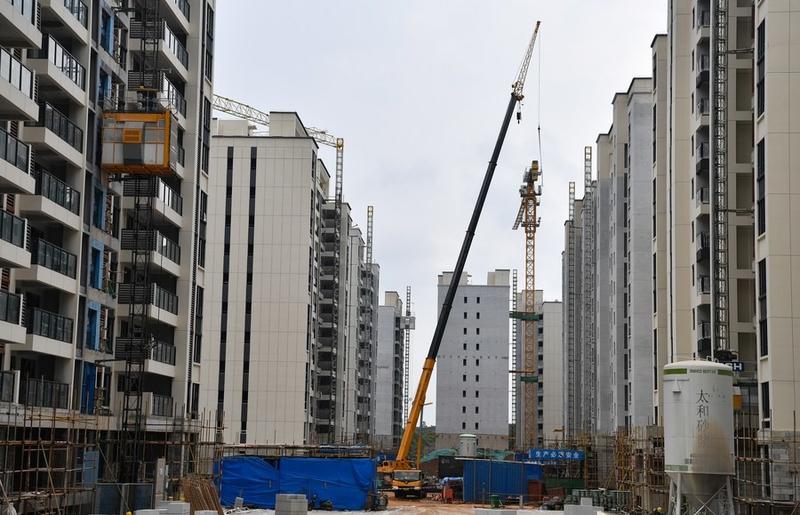 This photo taken on Feb 17, 2023 shows robot arms working on the production line at a glass factory in Jiamusi, Heilongjiang province, China. (PHOTO / XINHUA)
This photo taken on Feb 17, 2023 shows robot arms working on the production line at a glass factory in Jiamusi, Heilongjiang province, China. (PHOTO / XINHUA)
BEIJING - China's industrial production registered steady growth last year, accompanied by a faster pace of intelligent and green transformation, official data showed Wednesday.
The value-added industrial output, an important economic indicator, went up 4.6 percent year-on-year in 2023, the National Bureau of Statistics (NBS) said. In December alone, the figure grew 6.8 percent from a year earlier and 0.52 percent from November.
The industrial output is used to measure the activity of large enterprises, each of which has an annual main business turnover of at least 20 million yuan (about $2.81 million).
Kang Yi, head of the NBS, said China has made solid progress in promoting the intelligent and green transition of the manufacturing sector and fostering new growth drivers for the economy
"Industrial production picked up steadily, with equipment manufacturing growing rapidly," Kang Yi, head of the NBS, told a press conference Wednesday.
ALSO READ: Investing in China an opportunity, says premier in Davos
Following a sustained economic recovery, China's industrial businesses have bounced back due to improving market demand.
The NBS data showed in November, the combined profits of industrial businesses rose for a fourth straight month, up 29.5 percent from a year earlier. The industrial capacity utilization rate stood at 75.9 percent in the fourth quarter, up from 75.6 percent, 74.5 percent, and 74.3 percent in the third, second, and first quarter, respectively.
Kang said China has made solid progress in promoting the intelligent and green transition of the manufacturing sector and fostering new growth drivers for the economy.
The output of the equipment manufacturing sector expanded 6.8 percent year on year in 2023, faster than the average industrial production growth. The production of solar batteries, new energy vehicles and power generation equipment surged 54 percent, 30.3 percent, and 28.5 percent, respectively.
READ MORE: Experts highlight 'future industries'
New growth drivers have become important engines for high-quality development, NBS spokesperson Wang Guanhua said at the press conference.
 An employee configures a robot at an auto parts plant in Huzhou, Zhejiang province. (TAN YUNFENG / FOR CHINA DAILY)
An employee configures a robot at an auto parts plant in Huzhou, Zhejiang province. (TAN YUNFENG / FOR CHINA DAILY)
Retail sales climb
China's retail sales of consumer goods, a major indicator of the country's consumption strength, climbed 7.2 percent year-on-year in 2023, NBS data showed.
Wednesday’s data also showed that China's fixed-asset investment went up 3 percent year-on-year in 2023
The total investment stood at 50.3 trillion yuan (about $7.07 trillion) in the period, the NBS said.
READ MORE: China's industrial output up 6.6% in November
Total retail sales of consumer goods reached 47.15 trillion yuan (about $6.63 trillion) last year, according to the bureau.
In December alone, the retail sales of consumer goods rose 7.4 percent year-on-year.
Rise in fixed-asset investment
Wednesday’s data also showed that China's fixed-asset investment went up 3 percent year-on-year in 2023.
The total investment stood at 50.3 trillion yuan (about $7.07 trillion) in the period, the NBS said.
Investment in infrastructure construction and the manufacturing sector expanded 5.9 percent and 6.5 percent, respectively, compared with a year earlier, while property development investment dropped 9.6 percent.
ALSO READ: GDP of China's Guangzhou to surpass 3 trillion yuan in 2023
High-tech industries saw strong growth, with investment up 10.3 percent year-on-year. Specifically, investment in high-tech manufacturing and high-tech services sectors expanded by 9.9 percent and 11.4 percent, respectively.
More financial support was given towards improving people's livelihoods, as investment into production and supply of power, heating, gas and water jumped 23 percent year-on-year and agricultural investment rose by 9.3 percent.
In December alone, the country's fixed-asset investment edged up 0.09 percent month and month.
Per capita disposable income grows
China's per capita disposable income was 39,218 yuan (about $5,511) in 2023, up 6.3 percent year-on-year in nominal terms.
Meanwhile, the surveyed urban unemployment rate on average in China stood at 5.2 percent in 2023, down 0.4 percentage points from 2022, Wednesday's data showed
After deducting price factors, per capita disposable income rose 6.1 percent from the previous year, according to the NBS. The per capita disposable income for China's rural residents grew at a faster pace than that of the city dwellers in the period, it added.
READ MORE: Chinese farmers hit per capita income milestone
Separately, urban per capita disposable income came in at 51,821 yuan, up 5.1 percent in nominal terms and 4.8 percent in real terms, while the figure in rural areas stood at 21,691 yuan, up 7.7 percent in nominal terms and 7.6 percent in real terms.
During the period, the median of the nationwide per capita disposable income was 33,036 yuan, a nominal growth of 5.3 percent year-on-year.
 This photo taken on July 21, 2023 shows a job fair for college graduates in Jinhua, Zhejiang province, China. (PHOTO / XINHUA)
This photo taken on July 21, 2023 shows a job fair for college graduates in Jinhua, Zhejiang province, China. (PHOTO / XINHUA)
Urban unemployment rate stands at 5.2%
Meanwhile, the surveyed urban unemployment rate on average in China stood at 5.2 percent in 2023, down 0.4 percentage points from 2022, Wednesday's data showed.
The NBS said in a report that the employment situation is generally stable.
The surveyed urban unemployment rate in the country came in at 5.1 percent in December 2023, the NBS said, adding that the figure for 31 major Chinese cities stood at 5 percent for the whole year.
The total number of rural migrant workers grew by 1.91 million from a year earlier to 297.53 million in 2023, with their average monthly income up 3.6 percent year-on-year to 4,780 yuan (about $672).
READ MORE: China's employment stays stable, 10.22m new urban jobs added
The surveyed unemployment rate of the 16-24, 25-29 and 30-59 age groups of the workforce excluding students was 14.9 percent, 6.1 percent and 3.9 percent, respectively.
Kang said the bureau has excluded students when surveying unemployment in the 16-24 age group and newly created the 25-29 age group deducting students to reflect the unemployment situation among young people "more accurately and completely."
He added that students accounted for more than 60 percent of urban residents at the age of 16 to 24 last year.
The unemployment data for the newly added 25-29 age group can indicate the employment climate for youngsters in years after graduation, Kang said.
 This file photo taken on Sept 2, 2022 shows the construction site of a residential area in Jiangdong New Area of Haikou, Hainan province, China. (PHOTO / XINHUA)
This file photo taken on Sept 2, 2022 shows the construction site of a residential area in Jiangdong New Area of Haikou, Hainan province, China. (PHOTO / XINHUA)
Drop in home prices
NBS data released on Wednesday also showed that in 2023, property development investment stood at 11.09 trillion yuan (about $1.56 trillion), with investment in residential housing projects hitting 8.38 trillion yuan.
The total sales value of commercial housing reached 11.66 trillion yuan, the data showed.
Major Chinese cities reported falling home prices in December compared to the previous month.
In the four first-tier cities, namely Beijing, Shanghai, Guangzhou and Shenzhen, prices of new homes edged down 0.4 percent last month, while that of resold homes dropped 1.1 percent, according to the NBS data.
ALSO READ: More Chinese cities record falling home prices in October
Prices of both new homes and resold homes in 31 second-tier cities and 35 third-tier cities in general also went down in December from a month earlier, the data showed.
On a year-on-year basis, new home prices witnessed mixed performances in Chinese cities in December.
For new homes, first-tier cities saw prices down 0.1 percent; second-tier cities saw marginal price increases; and smaller cities reported a 1.8 percent price decline.
For resold homes, there were declines across the board in prices in December year-on-year, according to the data.


